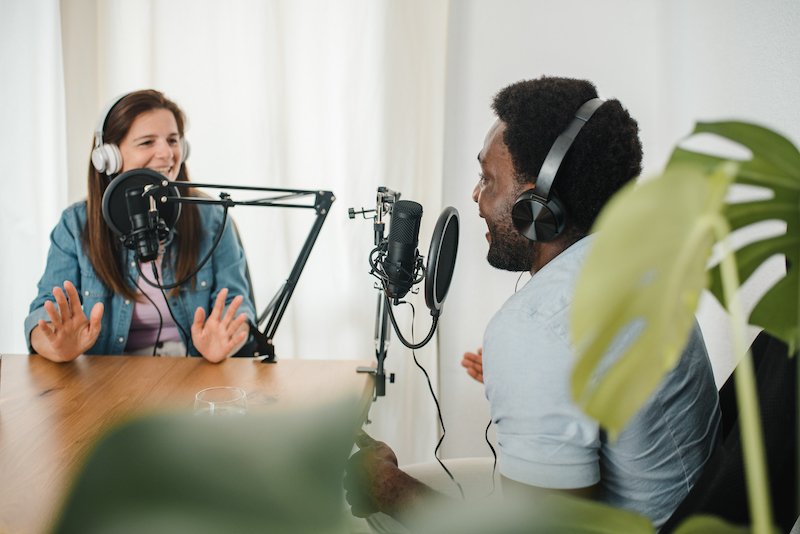Lesson Plan: Writing a podcast script
One of the most important parts of creating a podcast, especially with students, is writing a script. Red light fever is a real thing and often invokes filler words such as like, um, and ah. The recording and production process is SO much faster when you’re reading from a script, and the organization of an episode is so much clearer when you take students through the process. The Draft>Edit>Revise aspect of script writing can be a lengthy but in the long run, it is worth it. This lesson plan appears in my Podcasting Across the Curriculum publication, and is available exclusively through MusicFirst. Sign up HERE to get free access to the curriculum for 30 days.
Lesson Overview: This lesson will teach students the process of writing a script for a podcast and the basics of what should be included in a script. This lesson will also introduce the concept of Draft>Edit>Revise. Writing a script takes time and requires careful thought, editing, and revision.
The timeline for students completing this lesson can be one to three weeks, depending on how often you meet with your students. This lesson works most effectively when students are placed into small groups – preferably groups of 2. The student groups will hand in an initial draft of their script to the teacher for review and editing suggestions. Once they have gone through that process, they will need to hand in their final scripts before they start the recording process. Quality scripts take time to write. Allow your students that time to ensure successful results.
Objectives:
The learner will understand the process of writing a script for a podcast by reviewing the Draft>Edit>Revise process.
The learner will understand why scripts are necessary for recording podcasts by attempting to explain a concept without a script and then explaining the same concept while reading a script.
The learner will utilize the outline that they wrote in the previous lesson as the basis for their podcast script.
The learner will submit their podcast script draft to the teacher to begin the Draft>Edit>Revise process.
Materials:
Student created outlines from the previous lesson (Lesson 5)
Access to word processing software or Google Docs
Procedure:
This lesson will stress the importance of Students planning and organizing their podcasts BEFORE they start creating them. Drawing on my own teaching experience, students often want to skip this step and just start recording their podcasts. The best student-created podcasts that I have heard have always been those that were carefully planned out, edited, and revised. Attention to detail is a crucial part of creating a well-crafted podcast.
Teacher will review the Podcast Tips & Script Handout with Students.
Teacher and Students will discuss the contents of the handout and the Teacher will address any questions or concerns about the process.
If this is a group activity, Teacher will assign groups based on the similarity of the topics chosen by Students.
Allow sufficient class time (this could take multiple class sessions) for Students to write their scripts.
Teacher will monitor Student progress throughout the process and be available for editing suggestions, advice, etc.
After Students submit the first draft of their podcast scripts, the Teacher will provide feedback and suggestions to improve the scripts. This will likely be a multi-step process.
Once the final scripts have been agreed upon, Students should submit them to the Teacher for approval.
Extensions:
Students can share their scripts with other Students to facilitate the Draft>Edit>Revise process. Peer-to-Peer feedback can be very valuable
Students can research other podcasts on similar topics to get ideas for writing their own.
Student Handout
Podcast Tips & Script
The first step in creating a podcast is to choose a topic and then create an outline. The next step is to write a script for your podcast. While there are certainly some types of podcasts that don’t have detailed scripts, such as those containing interviews, most others do. Why are scripts so important when creating podcasts? There are a couple of good reasons:
You avoid what is known as “Red Light Fever”. It is very common to make mistakes when you first start podcasting – especially when you see that red recording light go on. It is also common to use “filler words” such as “like,” “um,” “so,” and “yeah.” When people record a podcast without a script, they may need to record themselves several times because they make mistakes during the recording. To illustrate this, record yourself talking about a specific topic – something as simple as “What did you do last weekend?” Most people add lots of “likes,” “um’s,” and “so’s” when they speak without a script, and many also make mistakes. Did you? It’s easier to make mistakes, and more frustrating, when you know you’re being recorded. Now, try writing down on paper what you did last weekend, and then record that. If you’re like most people, reading something that is written down eliminates most of those “like,” “ums,” and “so’s,” and you probably made few, if any, mistakes.
Writing a script makes your podcast more organized and clearer. Writing your outline probably took you some time. Writing a script takes time too. Reading and recording the script is probably the easiest part of creating a podcast.
It is always a good practice to use the Draft>Edit>Revise process when writing a script. Your first draft is just that – a first attempt. You should always read over your first effort so that you can see what you need to fix, add, or eliminate. The best option is to share your work with a friend, parent, classmate, or your teacher for their feedback. After the editing process, you should be able to revise your script to make it even better. You may need to repeat that process a few times before your script is ready to be recorded.
Now that you see why it’s important to write a script and to use the Draft>Edit>Revise process, here are a few helpful tips to keep in mind when writing a script:
Make your podcast sound like a casual conversation rather than a report. It makes it much easier to listen to.
Note when you want to add music or sound effects while writing your script.
Add performance notes to your podcast. For example: who is speaking each part, when you need to pause, breathe, stress certain words, or change the pace of your delivery.
Set the scene for your listeners. If you are talking about a specific place or event, use descriptive words so the listener can picture that place or event in their mind’s eye.
Don’t talk too fast! It’s common for students to read their scripts as fast as they can. Speaking too fast makes it difficult for listeners to understand what you are saying.
Come up with a title for your podcast that is both interesting and informative. Be creative!
Be yourself! Podcasts are best when listeners can relate to the hosts and guests.
Script Template Example:
The following is an example of a podcast script that will hopefully help you begin your own script writing process.
My Podcast Episode 1: Up, Up & Away!
[Podcast Theme Music plays]
Me: Welcome to Episode 1 of my podcast. This week we will be talking all about hot air ballooning – an incredible way to see the landscape around you while floating silently in a basket hundreds of feet above the ground. This past summer I had the amazing experience of going on a hot air balloon ride with my parents. It was something that my father always wanted to do, and my mother bought him a ride for his birthday. I was lucky enough to tag along for the ride.
[Pause]
In this episode I will be talking all about how hot air balloons are built, how they fly, why they make them so colorful, and where you can go to experience a hot air balloon ride for yourself. I will be joined by the pilot who flew our balloon, and he will tell us everything you ever wanted to know about this amazing form of travel.
[Podcast Theme Music fades]
[Sound effect of wind]
Me: Have you ever wondered what it feels like to fly? So have I. As far as I can tell, riding in a hot air balloon is as close to that feeling as you can get. It’s so quiet up in the sky. So peaceful. The only thing you can hear is the roar of the flame that heats the air inside the balloon, wind, and occasionally some birds.
[Sound effect of birds]
Me: This week I am joined by Skye Pilot, the person who flew the hot air balloon I rode in with my family. Skye has been flying hot air balloons for nearly 25 years, and she is kind of an expert on the history and operation of hot air balloons. Welcome to the show, Skye!
Skye: Thanks for having me. I am so excited to share my passion for hot air ballooning with you and your listeners.
Me: And we are happy you are here! Please tell us Skye, how did you first get interested in hot air ballooning?
-------------
While you may not have to write down your guest’s responses for a podcast script, the example above includes lots of information, such as when the music starts, who is speaking, sound effects, and so on. With this much detail, the actual recording process for your podcast will be much easier and less time consuming.
The best way to get started with writing your script is to take the outline that you wrote for Lesson 5, copy and paste it into a new document, and start writing!
Task: Writing Your Script
Using word processing software like Microsoft Word, Pages, or Google Docs, write a script for a 10-minute podcast episode based on your topic and outline from Lesson 5. When complete, "hand in" to your teacher to begin the Draft>Edit>Revise process.
If you are working in groups for this project, divide up the outline equally so that you can all write the script together. It is best to use something like Google Docs to collaborate as you will be able to see what everyone has written during the process.


